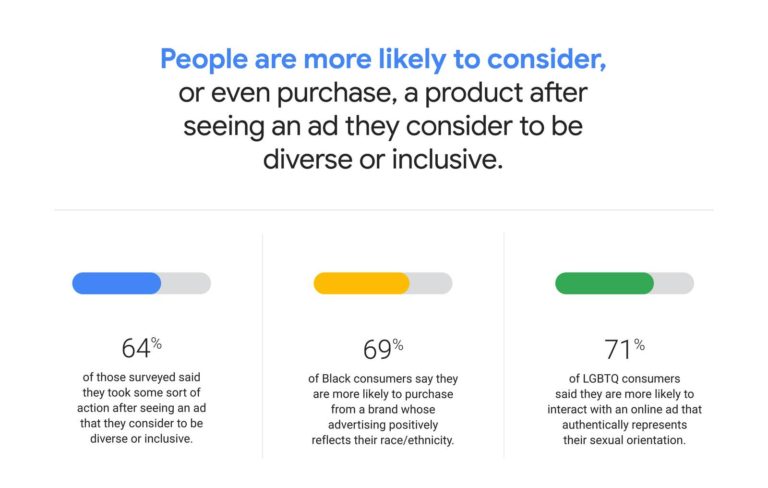Is your brand marketing truly inclusive?
Four questions you need to ask yourself and your team to truly become inclusive as a brand
Four questions you need to ask yourself and your team to truly become inclusive as a brand
As brand marketers, it’s our responsibility to create brands that people view positively and want to connect to. When marketing is inclusive, your brand has a better footing with an even larger audience and creates even stronger ties with your customers.
Inclusive marketing considers diversity in all forms— age, appearance, ethnicity, gender identity, language, socio-economic status, religion/spirituality, physical abilities, and neurodiversity—to reach people from all backgrounds and walks of life. When done correctly, inclusive marketing reflects real people in the real world, including those who are marginalized and underrepresented.
Sometimes, people think ‘diversity and inclusion’ and ‘inclusive marketing’ are the same things, but that’s not the case. Diversity and inclusion are important elements involved in building an inclusive workplace. Whereas, inclusive marketing is what you do to remove exclusion through marketing efforts.
Inclusive marketing is not about checking the boxes of diversity or creating a marketing campaign that looks like the audience you’re trying to reach. It’s about being open to everyone, acknowledging similarities and differences. Inclusive marketing is about treating people as a community and doing so in a way where your audience feels seen and authentically understood.
Microsoft is a great example. After realizing there was a need for adaptive gaming controllers to meet the needs of gamers with physical disabilities or limited mobility, they created an adaptive control with touchpads instead of buttons and bright colors for the visually impaired. Through the company’s ‘We All Win‘ Superbowl marketing campaign, Microsoft was able to include all users in video gameplay through the Xbox Adaptive Controller. This earned the gaming giant $35m in media and a 246 percent increase in the brand’s social share of voice.
The impact of inclusive marketing on business growth is well documented. According to a survey by Google and The Female Quotient, 64 percent of respondents took some action after seeing an ad they considered to be diverse or inclusive. And 69 percent of Black consumers said they are more likely to purchase from a brand whose advertising positively reflects their race or ethnicity. Additionally, 71 percent of LGBTQ+ consumers were more likely to interact with an ad that authentically represents their sexual orientation and identity.
Source: Think With Google
I think most marketing leaders are well-intentioned in their efforts to appeal to a wide audience of possible customers. But how can you determine if your marketing practices are truly inclusive? Consider asking yourself these questions:
It’s critical to take time to truly understand your audience, including their needs, their preferences, and their concerns. If you’re looking to build connections with a minority group, spend time learning about their personal experiences, their traditions, and their history. Doing market research and improving your cultural competency will provide you with the necessary insights to impact your audience and give a louder voice to the underrepresented.
I was really moved by Procter and Gamble’s marketing campaign ‘The Talk‘ which was launched in 2017 to raise awareness about the impact of bias across gender, race, age, weight, sexual orientation, and more. By bringing a series of difficult closed-door conversations African American mothers have with their children about racism and judgment, P&G was able to improve its cultural intelligence and show the importance of creating a less biased future.
In more recent times, their ‘They Will See You‘ YouTube campaign focused on LGBTQ+ visibility in advertising. What stood out was how P&G has embodied its roots, inclusion, and advocacy through its leadership as well. More details here on their statement – ‘Be seen. Be heard. Be proud.‘
Sometimes marketing leaders make the mistake of assuming that everyone within a specific demographic feels the same way or wants the same things. However, it’s extremely important to understand that what matters to each individual can vary greatly and these differences can impact their brand receptivity. Getting a better handle on things like education, interests, priorities, and risk tolerance can help ensure that you are setting an appropriate tone and using language that will be viewed favorably by your audience.
Today’s brands need to do much more than just say that inclusivity matters. They can’t just talk the talk, they need to walk the talk. To follow through, authenticity is essential. In fact, one study found that 90 percent of consumers say authenticity is important when deciding which brands they like and support.
Inclusive marketing must mirror an accurate reflection of the world around us, including real people in real situations. Don’t make the mistake of choosing images or language that reinforce stereotypes. Use this as an opportunity to challenge existing bias and build stronger connections between your audience and your brand. This could dive deeper into rethinking and redesigning your current digital marketing playbook and guidelines to ensure consistency.
Inclusivity must be firmly embedded in the entire marketing process, from initial ideation to campaign measurement. If it’s treated as an afterthought, you face the risk of alienating your audience, and in some scenarios, even see marketing failures that turn into PR nightmares. In addition, make sure that your marketing team reflects the diversity you’re trying to impact in your marketing efforts. Having a diversity of experiences and backgrounds to rely on can help plan and execute campaigns that foster stronger bonds with audiences.
Remember that inclusive marketing is not a trend, it’s a journey. To tell these stories, you need to find the right people on both, the brand side as well as the audience. Keep actively looking for them and pair new ways to tell your customers that you see them, hear them, and understand them. When you do this with authenticity, understanding, and empathy, you can more confidently say that your brand marketing is truly inclusive.
 Michael Collins is CMO and Managing Director of CFA Institute.
Michael Collins is CMO and Managing Director of CFA Institute.
He has led marketing teams in multimillion- and billion-dollar organizations, driving steady growth and profit through visionary marketing strategy and disciplined execution.
Michael’s worldwide team of 125 people aligns centralized global strategy with regional marketing execution.
Subscribe to the ClickZ newsletter for insights on the evolving marketing landscape, performance marketing, customer experience, thought leadership, videos, podcasts, and more.
Join the conversation with us on LinkedIn and Twitter.